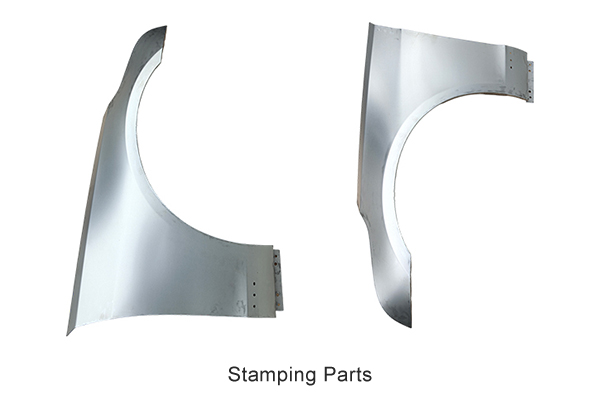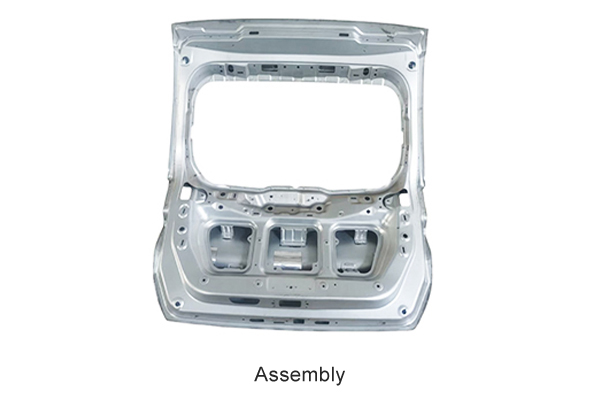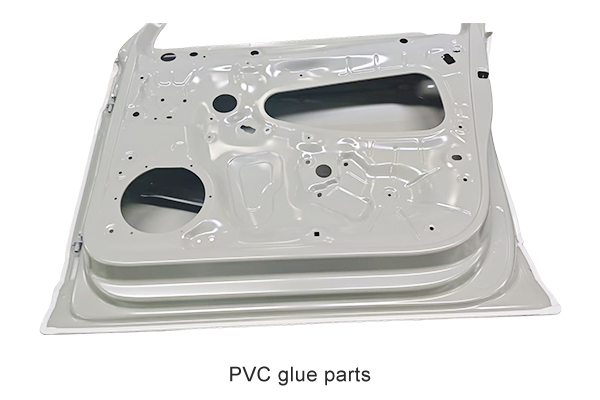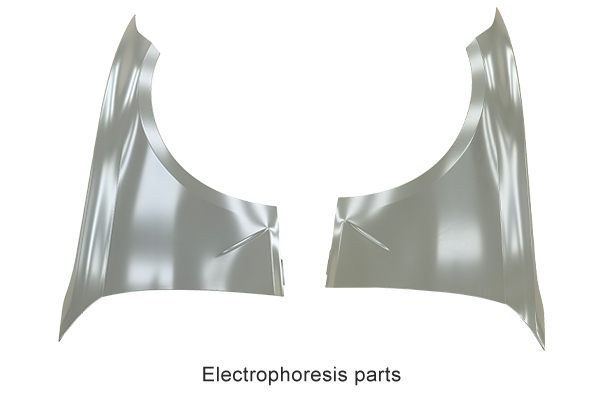Why is welding production key to improving the production efficiency of structural components such as mudguards and side panels?
Release Time : 2025-11-03
In modern manufacturing, especially in the automotive, rail transportation, and construction machinery industries, the production of metal structural components such as mudguards, side panels, doors, and covers faces increasing challenges of "high precision, high volume, and short cycle time." While these components do not directly participate in power output, they are crucial components of the vehicle's appearance, sealing, and safety structure. Traditional manual welding methods are no longer sufficient to meet consistency and capacity requirements. The introduction of welding production is becoming a core driving force for improving the production efficiency of such structural components, fundamentally reshaping the efficiency boundaries of the manufacturing process.
1. High-efficiency continuous production: Breaking through the bottleneck of manual cycle time
Structural components such as mudguards and side panels are typically large in size, have long welds, and regular shapes, making them ideal for automated operations. Welding production, through the coordinated operation of robots, positioners, and conveyor systems, can achieve 24-hour uninterrupted continuous welding. Compared to manual welding, which is limited by physical strength, concentration, and shift work, automated systems can complete dozens or even hundreds of welding tasks per hour. The production cycle is stable and controllable, significantly increasing output per unit time, making it particularly suitable for the assembly line needs of automotive OEMs.
2. Consistent Welding Quality: Eliminating Human Fluctuations
Manual welding is easily affected by factors such as operator skill level, emotional state, and fatigue, leading to inconsistent weld length, penetration, and forming quality, and even defects such as incomplete welds and weak welds. Automated welding systems, however, use preset programs to control current, voltage, speed, and trajectory, ensuring that the weld point position, weld length, and welding parameters of each mudguard or side plate are completely consistent. Combined with an online monitoring system, deviations can be fed back and corrected in real time, significantly reducing the defect rate and improving product reliability and assembly interchangeability.
3. Precise Handling of Complex Welds: Enhancing Process Adaptability
Modern mudguards and side plates often use irregular curved surface designs, with welds often being curves or spatial broken lines. Manual operation struggles to maintain uniformity on complex paths, while six-axis welding robots offer high flexibility, moving precisely along three-dimensional trajectories and easily handling complex structures such as curved edges, corners, and lap joints. Furthermore, the robot can integrate multiple welding processes, automatically switching according to the needs of different parts, achieving "one machine, multiple functions" and enhancing the flexibility and adaptability of the production line.
4. Reduced Material Waste and Rework Costs
Automated welding systems effectively reduce defects such as spatter, undercut, and burn-through by precisely controlling heat input and welding wire supply, thus reducing material waste. Simultaneously, stable welding quality significantly reduces subsequent secondary processing steps such as grinding, repair welding, and rework, saving labor costs and shortening the overall manufacturing cycle. This "one-time molding, no rework" advantage is particularly significant for mass-produced general-purpose parts such as mudguards.
5. Integrated Production: Achieving a Complete Closed Loop of "Loading—Welding—Unloading"
Advanced welding production often seamlessly integrates with automated loading and unloading systems, conveyors, and AGVs, forming a complete closed-loop process from sheet metal loading, positioning and clamping, automatic welding to finished product unloading. Operators only need to monitor the system from a safe area, avoiding frequent entry into the high-temperature, high-noise welding zone and improving operational safety. Simultaneously, the system can be networked with the MES (Manufacturing Execution System) to achieve real-time production data collection, process traceability, and quality analysis, helping enterprises move towards intelligent manufacturing.
6. Addressing Labor Challenges: Reducing Reliance on Skilled Welders
With the aging of the welding workforce and the increasing difficulty in recruiting, enterprises are becoming increasingly reliant on automated equipment. While welding production requires a higher initial investment, in the long run, it can significantly reduce reliance on highly skilled welders, minimize production fluctuations caused by personnel turnover, and improve supply chain stability.
For metal assembly parts with large batch sizes and relatively fixed structures, such as mudguards and side plates, welding production is not only a tool for "speeding up" but also a systematic solution for "improving quality, reducing costs, and increasing efficiency." Through continuous operation, precise control, and intelligent integration, it upgrades traditional manufacturing into a highly efficient, stable, and replicable modern production model. In the wave of intelligent manufacturing and Industry 4.0, automated welding has become an irreversible trend in structural component production and is key to enhancing enterprises' core competitiveness.
1. High-efficiency continuous production: Breaking through the bottleneck of manual cycle time
Structural components such as mudguards and side panels are typically large in size, have long welds, and regular shapes, making them ideal for automated operations. Welding production, through the coordinated operation of robots, positioners, and conveyor systems, can achieve 24-hour uninterrupted continuous welding. Compared to manual welding, which is limited by physical strength, concentration, and shift work, automated systems can complete dozens or even hundreds of welding tasks per hour. The production cycle is stable and controllable, significantly increasing output per unit time, making it particularly suitable for the assembly line needs of automotive OEMs.
2. Consistent Welding Quality: Eliminating Human Fluctuations
Manual welding is easily affected by factors such as operator skill level, emotional state, and fatigue, leading to inconsistent weld length, penetration, and forming quality, and even defects such as incomplete welds and weak welds. Automated welding systems, however, use preset programs to control current, voltage, speed, and trajectory, ensuring that the weld point position, weld length, and welding parameters of each mudguard or side plate are completely consistent. Combined with an online monitoring system, deviations can be fed back and corrected in real time, significantly reducing the defect rate and improving product reliability and assembly interchangeability.
3. Precise Handling of Complex Welds: Enhancing Process Adaptability
Modern mudguards and side plates often use irregular curved surface designs, with welds often being curves or spatial broken lines. Manual operation struggles to maintain uniformity on complex paths, while six-axis welding robots offer high flexibility, moving precisely along three-dimensional trajectories and easily handling complex structures such as curved edges, corners, and lap joints. Furthermore, the robot can integrate multiple welding processes, automatically switching according to the needs of different parts, achieving "one machine, multiple functions" and enhancing the flexibility and adaptability of the production line.
4. Reduced Material Waste and Rework Costs
Automated welding systems effectively reduce defects such as spatter, undercut, and burn-through by precisely controlling heat input and welding wire supply, thus reducing material waste. Simultaneously, stable welding quality significantly reduces subsequent secondary processing steps such as grinding, repair welding, and rework, saving labor costs and shortening the overall manufacturing cycle. This "one-time molding, no rework" advantage is particularly significant for mass-produced general-purpose parts such as mudguards.
5. Integrated Production: Achieving a Complete Closed Loop of "Loading—Welding—Unloading"
Advanced welding production often seamlessly integrates with automated loading and unloading systems, conveyors, and AGVs, forming a complete closed-loop process from sheet metal loading, positioning and clamping, automatic welding to finished product unloading. Operators only need to monitor the system from a safe area, avoiding frequent entry into the high-temperature, high-noise welding zone and improving operational safety. Simultaneously, the system can be networked with the MES (Manufacturing Execution System) to achieve real-time production data collection, process traceability, and quality analysis, helping enterprises move towards intelligent manufacturing.
6. Addressing Labor Challenges: Reducing Reliance on Skilled Welders
With the aging of the welding workforce and the increasing difficulty in recruiting, enterprises are becoming increasingly reliant on automated equipment. While welding production requires a higher initial investment, in the long run, it can significantly reduce reliance on highly skilled welders, minimize production fluctuations caused by personnel turnover, and improve supply chain stability.
For metal assembly parts with large batch sizes and relatively fixed structures, such as mudguards and side plates, welding production is not only a tool for "speeding up" but also a systematic solution for "improving quality, reducing costs, and increasing efficiency." Through continuous operation, precise control, and intelligent integration, it upgrades traditional manufacturing into a highly efficient, stable, and replicable modern production model. In the wave of intelligent manufacturing and Industry 4.0, automated welding has become an irreversible trend in structural component production and is key to enhancing enterprises' core competitiveness.








